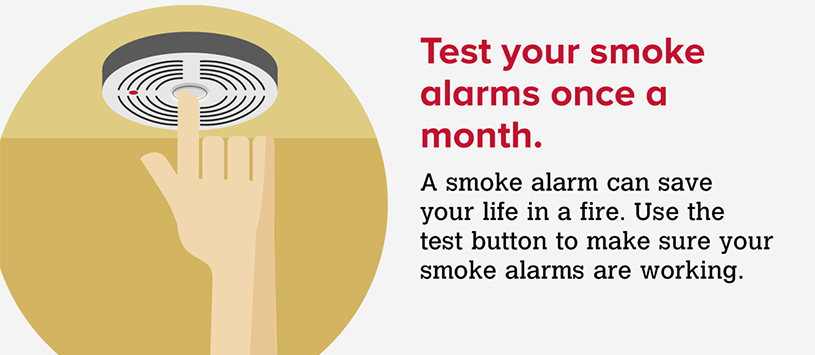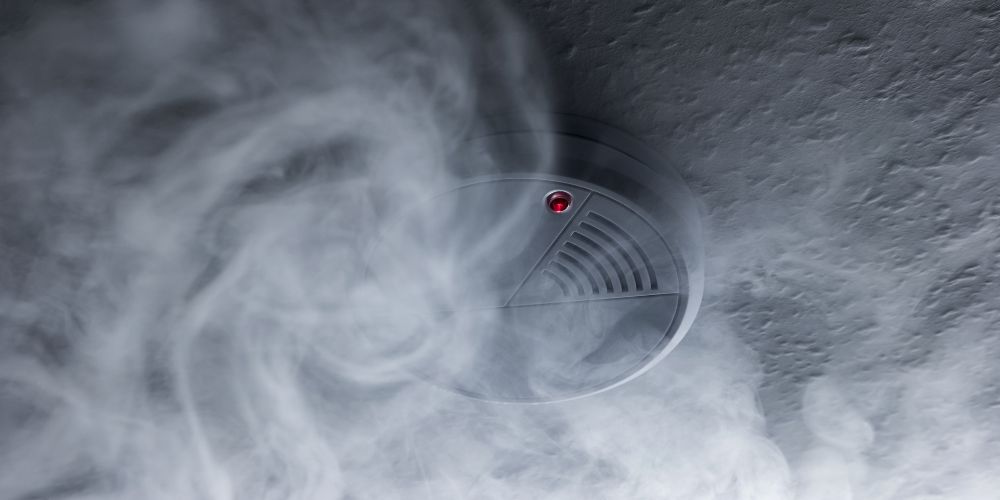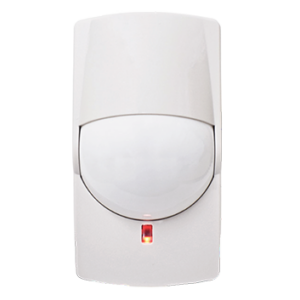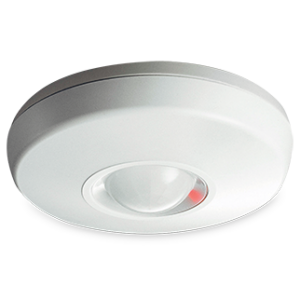In Australia, where bushfires and house fires pose significant risks, having the right smoke alarm is essential for protecting your home and loved ones. With various options available, selecting the most suitable smoke alarm can be overwhelming. This article aims to provide guidance on choosing the right smoke alarm tailored to the Australian context, ensuring optimal safety measures are in place.
Read more: Best Smart Sensors for Your Smart Home in 2024
Types of Smoke Alarm
In Australia, smoke alarms primarily fall into two categories: ionization smoke alarms and photoelectric alarms.
1. Ionization Smoke Alarm
- Ionization smoke alarms operate by using a small amount of radioactive material to ionize the air between two electrically charged plates. When smoke enters the chamber, it disrupts the ion flow, triggering the alarm.
- These alarms are highly effective at detecting fast-burning fires, such as those fueled by paper or flammable liquids.
2. Photoelectric Smoke Alarms
- Photoelectric smoke alarms employ a light source and a light-sensitive sensor. When smoke particles enter the chamber, they scatter the light, causing it to hit the sensor and trigger the alarm.
- This type of alarm is particularly adept at sensing smoldering fires, such as those ignited by overheated wiring or upholstery.
3. Dual-Sensor Smoke Alarms
- Dual-sensor smoke alarms combine ionization and photoelectric technologies to provide comprehensive fire detection capabilities. By leveraging the strengths of both technologies, these alarms offer enhanced reliability and sensitivity across a wide range of fire types.
In addition to these primary smoke alarm types, there are two other categories: Carbon Monoxide alarms, which target central heating systems in homes, and Heat Alarms, primarily used in kitchens to detect heat instead of smoke.
These additional alarms are often used in conjunction with one of the two primary types of smoke alarms for comprehensive fire detection coverage.
Determine Power Source: Battery Powered Smoke Alarms vs. Hard-wired Alarms
When it comes to choosing between battery-powered smoke alarms and hard-wired alarms, several factors need consideration. Both types have their own set of advantages and drawbacks, and the decision often depends on factors such as your home’s electrical setup, maintenance preferences, and budget. Let’s explore the differences between the two options to help you make an informed decision:

Battery-Powered Smoke Alarms
Advantages
- Easy Installation: Battery-powered smoke alarms are straightforward to install since they don’t require any wiring. You can place them anywhere in your home without the need for professional assistance.
- Versatility: Since battery-powered alarms don’t rely on electrical wiring, they can be installed in older homes or areas where hard-wired installations are not feasible.
- Portability: Battery-powered smoke alarms are portable, making them suitable for renters or individuals who may move frequently. You can easily take them with you when you relocate.
Drawbacks
- Battery Replacement: The primary drawback of battery-powered smoke alarms is the need for regular battery replacement. For optimal performance, batteries should be replaced at least once a year, which can be a hassle for some homeowners.
- Limited Lifespan: Battery-powered smoke alarms typically have a shorter lifespan compared to hard-wired alarms. While they offer reliable performance, they may need to be replaced more frequently, increasing long-term costs.
- Maintenance: Since battery-powered alarms rely solely on batteries for power, they may be more prone to failure if batteries are not replaced promptly or if the unit malfunctions.
Hard-Wired Smoke Alarms
Advantages
- Constant Power Supply: Hard-wired smoke alarms are connected to your home’s electrical system, providing a continuous power supply. This eliminates the need for battery replacement and ensures uninterrupted operation.
- Interconnectivity: Hard-wired alarms can be interconnected, meaning that when one alarm detects smoke, all interconnected alarms in the home will sound simultaneously. This feature enhances early warning capabilities and can be crucial in larger homes or multi-story residences.
- Integration with Home Security Systems: Hard-wired smoke alarms can be integrated with home security systems, offering additional layers of protection and functionality, such as remote monitoring and alerts.
Drawbacks
- Professional Installation Required: Installing hard-wired smoke alarms typically requires professional assistance, especially if your home is not already wired for them. This can add to the initial installation costs.
- Dependency on Electrical System: Hard-wired alarms rely on your home’s electrical system, meaning they may be rendered ineffective during power outages unless they have backup battery capabilities.
- Limited Placement Options: Hard-wired smoke alarms are fixed to specific locations where electrical wiring is available, limiting flexibility in placement compared to battery-powered alarms.
Consider factors such as ease of installation, maintenance requirements, reliability, and long-term costs when making your decision. Whichever option you choose, ensuring that your smoke alarms are properly installed, regularly tested, and maintained is crucial for maximizing home safety.
How Many Smoke Alarms Does My Home Need?
The number of required smoke alarms varies depending on your location in Australia. Each state and territory has its own regulations and recommendations:
- New South Wales (NSW): Fire and Rescue NSW mandates a minimum of one smoke alarm per floor. Additionally, they advise installing smoke alarms in every bedroom, living spaces such as hallways and stairwells, as well as the garage. Preference is given to photoelectric smoke alarms.
- Victoria (VIC): The Metropolitan Fire Brigade stipulates at least one smoke alarm in every household, with a preference for photoelectric alarms.
- Queensland (QLD): requires a photoelectric smoke alarm on each level, with the option of either mains-powered or equipped with a 10-year battery.
- South Australia (SA): mandates at least one smoke alarm per dwelling, specifying either mains-powered or 10-year battery-operated. Interconnection may also be required.
- Western Australia (WA): According to the Department of Fire & Emergency Services, homes must have a mains-powered smoke alarm per floor. Battery-powered alarms are acceptable if the property lacks mains power connection.
- Northern Territory (NT): Fire & Rescue Services insist on functioning smoke alarms in all residential properties. They advocate for upgrades to mains-powered or 10-year battery photoelectric alarms.
- Australian Capital Territory (ACT): the Emergency Services Agency requires homes constructed or renovated post-1997 to have a minimum of one mains-powered smoke alarm. Photoelectric smoke alarms are recommended. Replacement of ionisation smoke alarms nearing expiry is also advised.
The Tasmanian Government mandates all rental properties to have at least one 10-year lithium battery alarm, or preferably mains-powered, installed.
Placement of Smoke Detectors
- Bedrooms: Install smoke detectors in every bedroom and sleeping area to ensure occupants are alerted promptly in the event of a fire, especially during nighttime when individuals are most vulnerable.
- Hallways: Place smoke detectors in hallways leading to bedrooms and other areas of the home. Hallways serve as natural pathways for smoke to travel, making them critical locations for detector placement.
- Living Areas: Install smoke detectors in living rooms, dens, and other common areas where people spend significant amounts of time. These detectors can provide early warning in case a fire starts while occupants are awake and active.
- Kitchen: While kitchens can pose challenges for smoke detectors due to cooking-related false alarms, it’s essential to install detectors nearby, preferably away from cooking appliances. Consider using photoelectric detectors in kitchens to minimize false alarms triggered by cooking smoke.
- Basements and Attics: Install smoke detectors in basements and attics, as these areas are often where fires can start undetected and spread rapidly. Ensure detectors are placed on the ceiling or high on the walls to maximize coverage.
How to Test Your Smoke Alarm?

Smoke alarms offer a simple and cost-effective means of safeguarding your family and home against the threat of fire. However, ensuring their functionality requires regular testing, ideally on a monthly basis.
Before initiating the test, it’s crucial to inform other household members, as the alarm’s sound may startle them. Additionally, it’s advisable to have someone stationed at the farthest point in the house to ensure the alarm’s audible range covers the entire home. Here’s a step-by-step guide on how to test your smoke alarm:
- Position yourself on a chair or step ladder to access the smoke alarm easily.
- Depress the button located on the smoke alarm.
- If you hear a distinct sound, your smoke alarm is operating as intended.
- In the absence of a beep, it indicates a potential issue such as failing batteries or a malfunctioning smoke alarm. In such cases, replace the batteries and retest the smoke alarm. If the problem persists, consider replacing the smoke alarm altogether.
By following these steps, you can ensure that your smoke alarm remains in proper working condition, providing vital protection against fire hazards in your home. Regular testing is a small yet significant measure in maintaining the safety and well-being of your household.
What to Consider When Purchasing a Smoke Detector
Smoke detectors are essential components of home safety, providing early warnings in the event of a fire. While all smoke alarms in Australia meet the requirements of the Australian Standard, there are additional features and functions to consider when selecting the right detector for your home:
- 10-Year Battery Life: Opt for smoke alarms equipped with a 10-year lithium battery, especially when hard-wired units are not feasible. These models ensure long-lasting reliability without the need for frequent battery replacements.
- Hush Button: Look for smoke alarms with a hush button feature, which allows you to temporarily silence the alarm during false alarms, such as when cooking generates minor kitchen smoke. Some advanced models even come with a remote control to deactivate the alarm while smoke dissipates, providing added convenience.
- Escape Light: Consider smoke detectors with built-in escape lights that activate when the alarm sounds. These lights illuminate the surrounding area, guiding occupants to safety in case of a power outage or low visibility conditions.
- Test Button: Ensure the smoke alarm includes a test button for easy functionality checks. Pressing this button allows you to verify if the alarm is operating correctly. Additionally, some models offer alternative testing methods, such as using a torch to simulate smoke detection.
- Interconnectability: Choose smoke alarms that are interconnectable, especially for mains-powered units and select battery-powered models. Interconnectable alarms can be linked together, so when one alarm detects smoke, all interconnected units sound simultaneously. This ensures that everyone in the household is promptly alerted to potential fire hazards, enhancing overall safety.
When purchasing a smoke detector, prioritize these features to maximize the effectiveness of your home’s fire detection system. Additionally, ensure proper installation and regular maintenance to keep your smoke alarms in optimal working condition and provide continuous protection for your family and property.
How Long Do Smoke Detectors Last?

Smoke detectors are essential components of home safety systems, providing early warning in the event of a fire. However, like all electronic devices, smoke detectors have a limited lifespan. The longevity of a smoke detector depends on factors such as the type of detector, its power source, and the manufacturer’s specifications. Here’s a general overview of how long smoke detectors typically last:
- Ionization Smoke Detectors: Ionization smoke detectors typically have a lifespan of 8 to 10 years. Over time, the radioactive material used in these detectors to ionize air particles may decay, leading to reduced sensitivity and accuracy in detecting smoke particles.
- Photoelectric Smoke Detectors: Photoelectric smoke detectors also have a lifespan of around 8 to 10 years. While they do not contain radioactive materials like ionization detectors, the internal components of photoelectric detectors may degrade over time, affecting their performance.
- Combination Smoke Detectors: Combination smoke detectors, which utilize both ionization and photoelectric sensors, generally have a similar lifespan of 8 to 10 years. Regular testing and maintenance are essential to ensure optimal performance throughout their lifespan.
- Hardwired Smoke Detectors: Hardwired smoke detectors, which are connected to the home’s electrical system, typically last longer than battery-powered detectors. However, they still have a lifespan of around 8 to 10 years. Regular testing and inspection of hardwired detectors are necessary to identify any issues that may arise over time.
- Battery-Powered Smoke Detectors: Battery-powered smoke detectors typically have a shorter lifespan compared to hardwired detectors, ranging from 5 to 7 years. The lifespan of the batteries themselves also plays a significant role in the overall longevity of battery-powered detectors. Regular battery replacement is essential to ensure continuous operation.
It’s important to note that while smoke detectors may still appear functional after their recommended lifespan, their reliability and effectiveness in detecting smoke diminish over time. Therefore, it’s crucial to replace smoke detectors according to the manufacturer’s recommendations or every 8 to 10 years, even if they seem to be working correctly. Additionally, staying vigilant with regular testing, maintenance, and battery replacement can help ensure that your smoke detectors provide reliable protection for your home and family.
Maintenance of Smoke Alarms
- Regular Testing: Test smoke alarms monthly by pressing the test button to ensure they are functioning correctly. If the alarm does not sound, replace the batteries immediately.
- Battery Replacement: Replace smoke alarm batteries at least once a year, or sooner if the low-battery warning chirps are heard. Consider using long-life lithium batteries for extended durability.
- Cleaning: Keep smoke alarms clean from dust, dirt, and debris, as these particles can interfere with their operation. Use a soft brush or vacuum attachment to gently remove any accumulated debris.
- Replacement: Replace smoke alarms every ten years or according to the manufacturer’s recommendations, as the sensitivity of the sensors may degrade over time.
Conclusion
Smoke alarms are indispensable guardians of home safety, providing early warnings that can mean the difference between life and death in the event of a fire. By understanding the different types of smoke alarms, implementing strategic placement strategies, and adhering to regular maintenance practices, you can ensure your home is equipped with reliable fire detection capabilities. Remember, investing in smoke detectors is not just a precautionary measure; it’s a vital safeguard for your loved ones and your property.
Explore more smart sensors here.
-
BES SR570000 RF KNX HIDDEN Movement Sensor Brilliant
$235.36Please login to see trade price
Add to cart -
CYTECH C-BUS TO KNX 2-WAY TRANSLATOR – Brilliant
$607.18Please login to see trade price
Add to cart -
-
-
-












